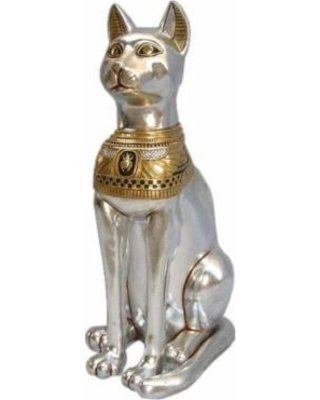Egyptians have a very rich and intriguing history that has been retold countless times by historians over time.
One such well researched and written aspect is their affiliations to gods and how gods formed an integral part of the Egyptian society.
Many ancient Egyptian deities appear as animals which are known to represent the people’s deep connection to nature. There were several feline deities in ancient Egypt but one that had a huge cult and much prominence was the goddess Bastet.
Bastet, also known as the cat goddess of joy, passion and love, women, pleasure and ‘all things nice’, was once believed to be a ferocious protector of kings and an avenger.
With time, the meanings associated with the goddess ameliorated to the more sensual and domesticated cat around 1500 BCE.
Due to the fertility of domestic cats, and their graceful, coy, and friendly nature, Bastet was also given these attributes and became widely associated with fertility, sensuality, grace, and family as well.

She was also one of the chief feminine deities in the pantheon, being the goddess of sex and pregnancy, of childbirth and motherhood.
Scholars say she gained so much popularity around the 22nd Dynasty of Hedjkheperre Setepenre Shoshenq I in 954 BC. Bastet’s cult evolved and she became one of the few deities who had its place of worship in a self-named city, Bubastis.
Hedjkheperre made Bubastis his center and began building a sophisticated temple that was later completed by his grandson, Osorokon III.
Usbaste, Bast, Baast, Baset or more widely Bastet has different school of thoughts on the origin of her name. Some have said its true meaning is “She of the Ointment Jar” that was derived from hieroglyphics.
Early representations of her were that of a woman with a lion head which was very similar to the leonine goddess Sekhmat who had a fiercer depiction in her effigies.
The slender woman with the catlike head “carries an ancient percussion instrument, the sistrum, in her right hand; a so-called aegis, or breastplate (in Bastet’s case, surmounted with the head of a lioness), in her left hand; and a small bag over her left arm. She wears an elaborately ornamented dress. Her cult was carried to Italy by the Romans, and traces have been found in Rome, Ostia, Nemi, and Pompeii,” writes Britannica.com.

The usual appearance on the collectables is one of a domestic cat, slender and graceful, surrounded by many kittens. Another common depiction is of a cat seated on its haunches, decorated with jewellery.

As the violent or aggressive connotations to the god softened so did its statues, from ‘savage avenger to a helper or daily companion.’
Hence, she is sometimes depicted as a domesticated cat with no human attributes which made a cat a revered and sacred animal that contributed to its worship among the Egyptians.
Cats were mummified on a very large scale to appease the deity Bastet and large burial grounds of mummified cats have been discovered at Saqqara burial grounds, Memphis; Bubastis and Speos Artemidos near Beni Hasan.
In fact, ‘cat farming’ became a very lucrative trade due to the large numbers needed for mummification. The burial grounds can be said to have millions of mummified cats. On the contrary, unauthorised killing of cats was one of the highest-ranking offences that was punishable by death.
Diodorus Siculus wrote about a lynching of a Roman citizen in Egypt for killing a cat. According to the account, the citizen was lynched immediately to death by an angry mob of Egyptian citizens. To them, hurting a cat was a great insult. An accidental or purposeful killing of a cat was still punishable by death.
The goddess was revered as the protector of households and any reverence for Bastet was ‘personified by the pet cat.’

“Once a pet cat would perish from old age, the entire family would descend into a period of profound grief. They would shave off their eyebrows as a sign of mourning and would be in such a sorrowful period until their eyebrows grew back,” said Ancient Origins.
Each year at the festival to honor Bastet, as many as 700,000 people travel the Nile to Bubastis to celebrate with rituals and sacrifices whiles they consume so much wine.
Herodotus had once witnessed such festival and wrote that in attendance were more female worshippers than men. These females probably hoped to be graced with the gift of fertility and be more liberated with their sensuality.
Geraldine Pinch, citing Herodotus, claims, “women were freed from all constraints during the annual festival at Bubastis. They celebrated the festival of the goddess by drinking, dancing, making music, and displaying their genitals.”
This “raising of the skirts” by the women, described by Herodotus, had as much to do with freedom from social constraints as it did with the fertility associated with the goddess.”
In historic texts, Bastet is mentioned as the royal protector where some say is her most prominent role in history. History has it that she played the role of both a nurse and mother to the king.

The goddesses son as recorded is Maahes, a Leonine male god conceived with the god Ptah. Maahes was the god of war and knives, known as the Wielder of the Knife, the Scarlet Lord, and the Lord of Slaughter.
He was portrayed as a man with a fearsome head of a lion, like the early effigies of his mother Bastet.
Bastet remained one of the most venerated, widely-known and potent deities worshipped throughout the remainder of Egypt’s history even transcending into the Roman Empire until the rise of Christianity buried the worship of other gods.










